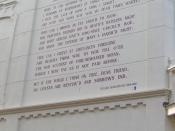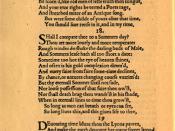The Shakespearean sonnet takes on many distinguishing qualities. The dialectic qualities of conflict/harmony balance are an important piece in adding understanding with the poem. This poem has arising conflicts from the beginning and takes aim at companionship at its worst. With only fourteen lines in a sonnet's length, it would appear that one could not peruse his work. On the contrary, Shakespeare's sonnets have more depth to it than meets the eye. I will speak about language, tone, imagery, and theme in Shakespeare's composition of sonnet 9.
Language is the most interesting aspect in this work. The opening line states, "Is it for fear to wet a widow's eye/That thou consum'st thyself in single life?" The letter "w" is used extensively to emphasize widow and wife as the female/woman focal points of the sonnet. Shakespeare also added many "w" words threaded through it for effect.
The use of "m" words, all of which relate to the male subject, alludes to the opposite gender of the subject to a prospective wife, but also the marital state opposite to what the subject ought to be in.
In line 3, "Ah, if thou issueless shalt hap to die, /The world will wail thee like a makeless wife." The subject being issueless causes a prospective wife to be makeless, without the required husband: The use of w and m continues:
The world will be thy widow, and still weep
That thou no form of thee hast left behind,
When every private widow well may keep
By children's eyes her husband's shape in mind
"W" usage diminishes whilst the "m" usage increases in conclusion. "No love toward others in that bosom sits/ That on himself such murd'rous shame commits." The conclusion was very critical linguistically, because he is ultimately encouraging men to father children. This...


